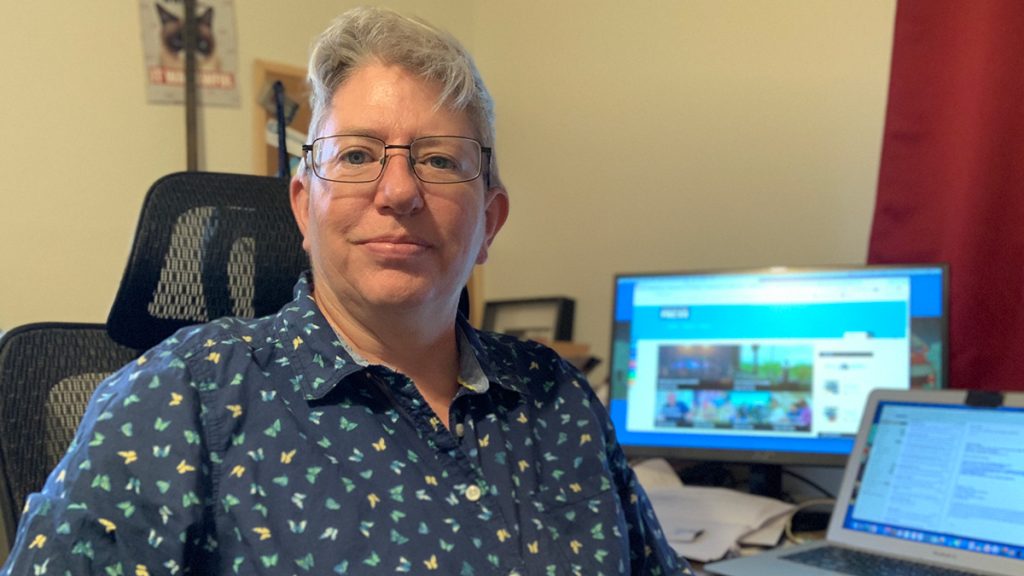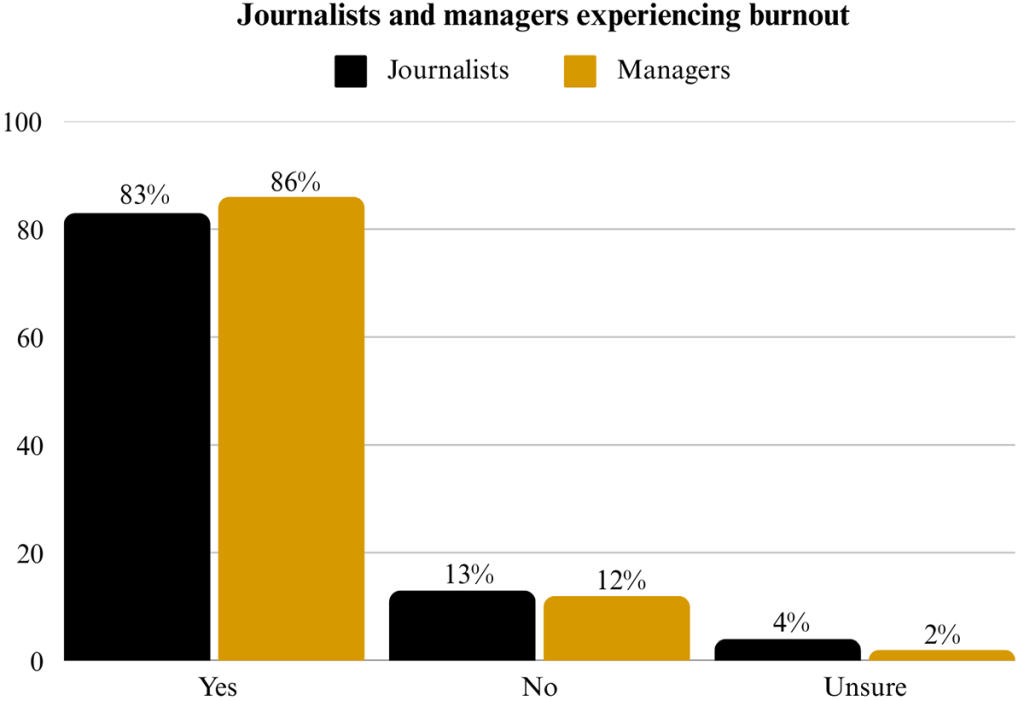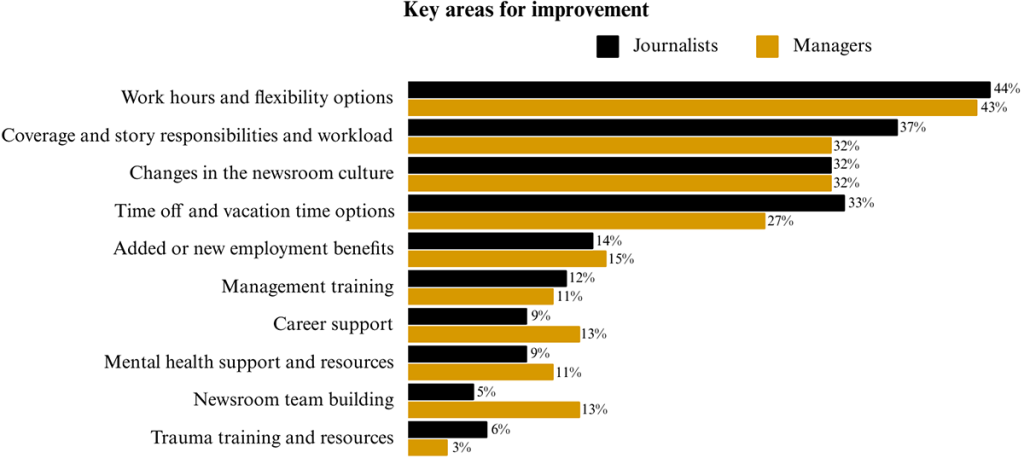
Juno Ogle is the only reporter for the Silver City Daily Press
Newsroom burnout: The strain of doing more with less
Živilė Raškauskaitė is a doctoral student at the Missouri School of Journalism, specializing in media sociology. Her research explores the complex relationships between journalists and audiences, including topics such as dark participation online and news avoidance.
Juno Ogle has always been passionate about journalism: from her early days in high school, following her brother’s footsteps by joining the school newspaper to her current role as the only full-time reporter at the Silver City Daily Press in New Mexico. But now, after more than two decades in the field, Ogle faces a challenge that has become all too familiar in the local newsrooms across the United States – burnout.
“The burnout really started after our staff size shrank,” Ogle said, remembering her time at the Hays Daily News in Kansas, which was bought by GateHouse Media, now part of Gannett. “The work just got harder.”
She said the increased demands and reduced resources have taken a toll on her enthusiasm for the job.
After nearly two decades in Kansas, Ogle moved to New Mexico, hoping a change of scenery might reduce some of her burnout. But at the Silver City Daily Press, she works as a solo full-time reporter covering multiple municipalities, school districts, and a state university, often without much support.
For Ogle, burnout is not just about exhaustion. It is the slow, creeping sense of losing the drive that once fueled her work.
“I’m just kind of losing my ability to really care about doing the stories,” she said. “Sometimes I just feel like I don’t have the time to do my best work on anything.”
Ogle highlighted a common frustration among journalists pushed beyond their limits. As a survey conducted in 2023 by SmithGeiger and the Reynolds Journalism Institute demonstrated, burnout is not just a personal battle but also a systemic challenge affecting newsrooms across the United States. The active journalists and managers agree that the most significant negative factor impacting journalism is that newsrooms are being forced to do more with less. According to the survey, 80% of journalists experience burnout, and 91% have seen their colleagues struggle with it.
Burnout drives journalists away
As pressures in the media industry mount, burnout is prompting a growing number of journalists to leave their careers. The survey found that 20% of active journalists are either planning to leave the profession or have already done so due to burnout.
Janice Turi is one of them. Her decade-long journalism career spanned from the Midwest to Silicon Valley, where she covered topics such as regional planning and commercial real estate. But as she advanced in her career, the burden of burnout became overwhelming, leading her to leave the media industry.
Turi said the constant pressure to produce more stories, meet tighter deadlines and navigate toxic work environments took a toll on her mental and physical health.
“I ended up needing a long break — about a year and a half — where I couldn’t work full time because I was so deeply burnt out,” Turi said.
During this time, Turi sought therapy and focused on recovery.
“I was so burnt out that even trying to write an article would bring me to tears,” she said.
Burnout creeps in slowly, often hidden beneath the adrenaline of chasing stories, contacting sources and meeting deadlines. Turi noticed the warning signs early: panic attacks before going to the newsroom, constant fatigue and a growing sense of dread about what each day would bring.
“You’re never turning your brain off from work,” she said. “Even if I tried to take a vacation, my brain never stopped being at work.”
What made matters worse was that high performance only led to heavier workloads.
“Their [editors’] reward is more work,” Turi said.
Despite her passion for journalism, Turi made the difficult decision to leave the industry. She now works in academia, where she has found a more balanced and supportive work environment.
“I still work hard, but when I’m off, I’m off,” she said. “After journalism, anything feels easier.”
Managers face burnout pressures
Managers at media outlets feel the strain as well. The survey by SmithGeiger and RJI found that while 11% of active managers have never considered leaving journalism due to burnout, 18% are actively planning to leave or have already left.
Amber Hair, co-managing editor at the Pacific Coast Business Times, highlighted the challenges she faces as a manager in a small newsroom.
“We have a very small team, and we pull a lot out of our hats,” she said. “The cost of that is burnout when we ask too much of ourselves.”
Like Ogle, Hair works in an environment with limited resources, where the lack of formal mental health support adds to the stress on both journalists and managers.
“We’re not a big enough company [for formal mental health support],” she said. “Honestly, we don’t have a specific plan for mental health.”
Areas for improvement: Work hours, flexibility and workload
The survey by SmithGeiger and RJI identified several key areas where changes could significantly reduce burnout among journalists. The most cited aspects for improvement among journalists included work hours, flexibility options, and coverage and story responsibilities.
Active journalists emphasized the need for more flexible work arrangements. Many suggested offering a four-day work week, more hybrid shifts that allow work from home and increased opportunities for remote work. Additionally, there was a call for more flexible shifts, such as four, eight or 10-hour workdays, to better accommodate individual needs.
When it comes to coverage and story responsibilities, journalists expressed a desire for more input into how they do their jobs. They advocate for regular evaluations of workloads across different teams and for managers to allow employees to have a say in how their work gets done.
Academic research shows that more freedom and space for creativity reduces the level of burnout. For instance, a 2024 study of the 30 largest U.S. local television markets by Carey L. Higgins-Dobney, titled “Make Slot Not Art: Creativity and Burnout in US Local Television Newsrooms,” revealed that a heavy workload, role ambiguity and limited opportunities for creative expression exacerbate feelings of burnout and prompt thoughts of leaving the profession. In contrast, local TV news workers who had creative control over their work, from selecting stories to handling the final edits, reported higher job satisfaction. The study suggested that news managers should offer more creative autonomy to their staff to mitigate burnout and increase job satisfaction.
The need for cultural change in newsrooms
Beyond structural changes, the SmithGeiger and RJI survey revealed a need for a shift in newsroom culture. Many journalists felt that greater recognition and acknowledgment of their valuable work could help mitigate feelings of burnout. They also suggested that managers should identify tasks that can be deprioritized to free up resources for new ideas or key priorities.
Moreover, clearer communication about newsroom priorities and fostering a sense of purpose among team members were seen as crucial steps toward improving the overall newsroom environment. Encouraging a culture where employees feel valued and understood could significantly reduce the mental exhaustion and overwhelming stress that many journalists report.
Ogle herself has found some solace in small moments of personal fulfillment. A nature lover and photographer, she often takes her camera and her dog for hikes in the nearby Gila National Forest.
“It’s just kind of therapeutic to be able to get out and do that,” she said.
However, even with these coping mechanisms, Ogle knows that systemic changes are necessary to prevent burnout from pushing more journalists out of the profession.
“We definitely need to keep people and get more people into it,” she said. “What we do is very important.”
Despite the overwhelming workload and the emotional toll, Ogle remains in journalism, driven by a sense of duty to her community and a reluctance to leave her newspaper in the lurch.
“The community needs someone there,” she said. “So, there’s that feeling of obligation to the newspaper, to the community that somebody needs to be doing this. And if I leave, you know, there’s not going to be someone.”
Cite this article
Raškauskaitė, Živilė (2025, Feb. 14). Newsroom burnout: The strain of doing more with less. Reynolds Journalism Institute. Retrieved from: https://rjionline.org/news/newsroom-burnout-the-strain-of-doing-more-with-less/


